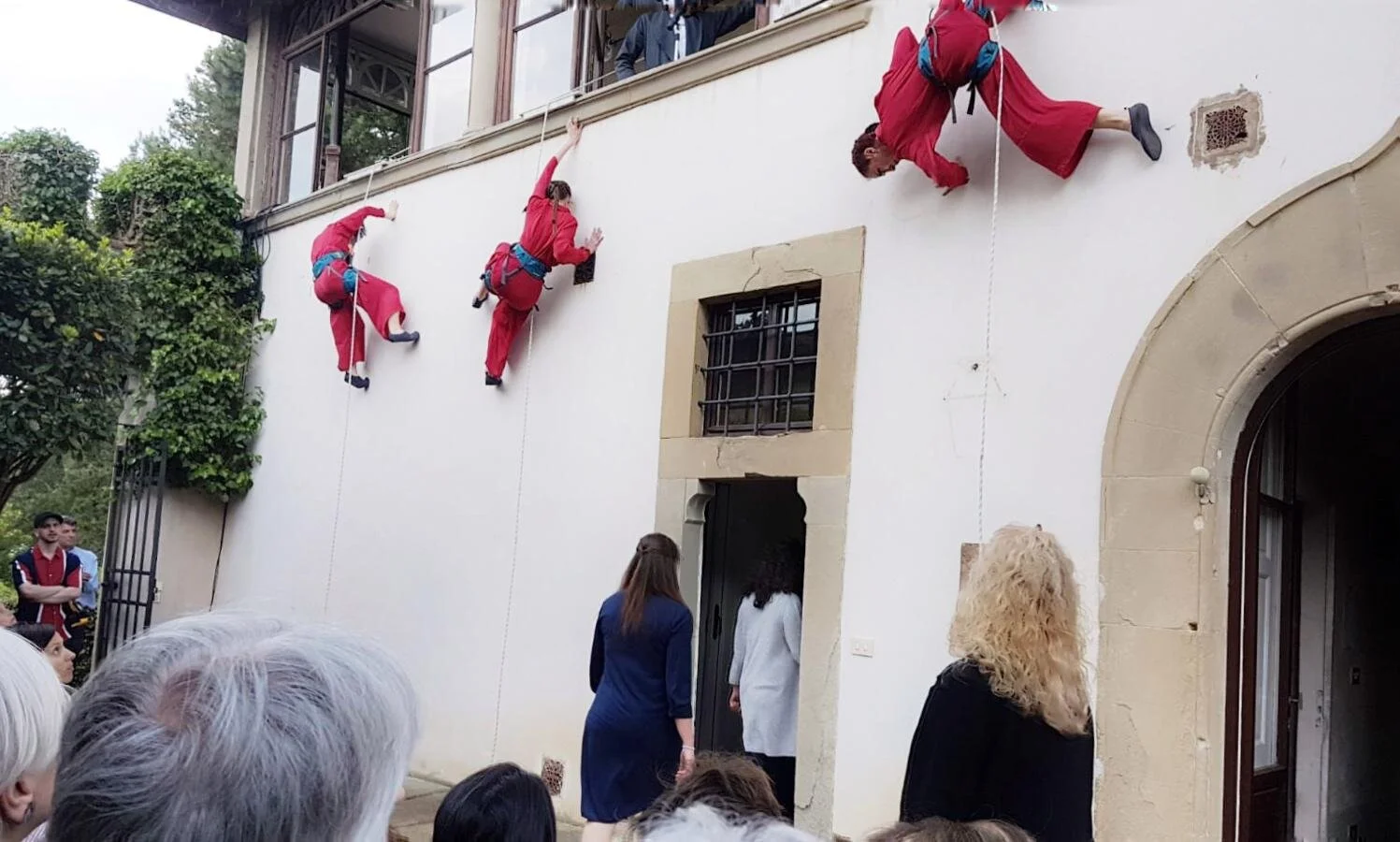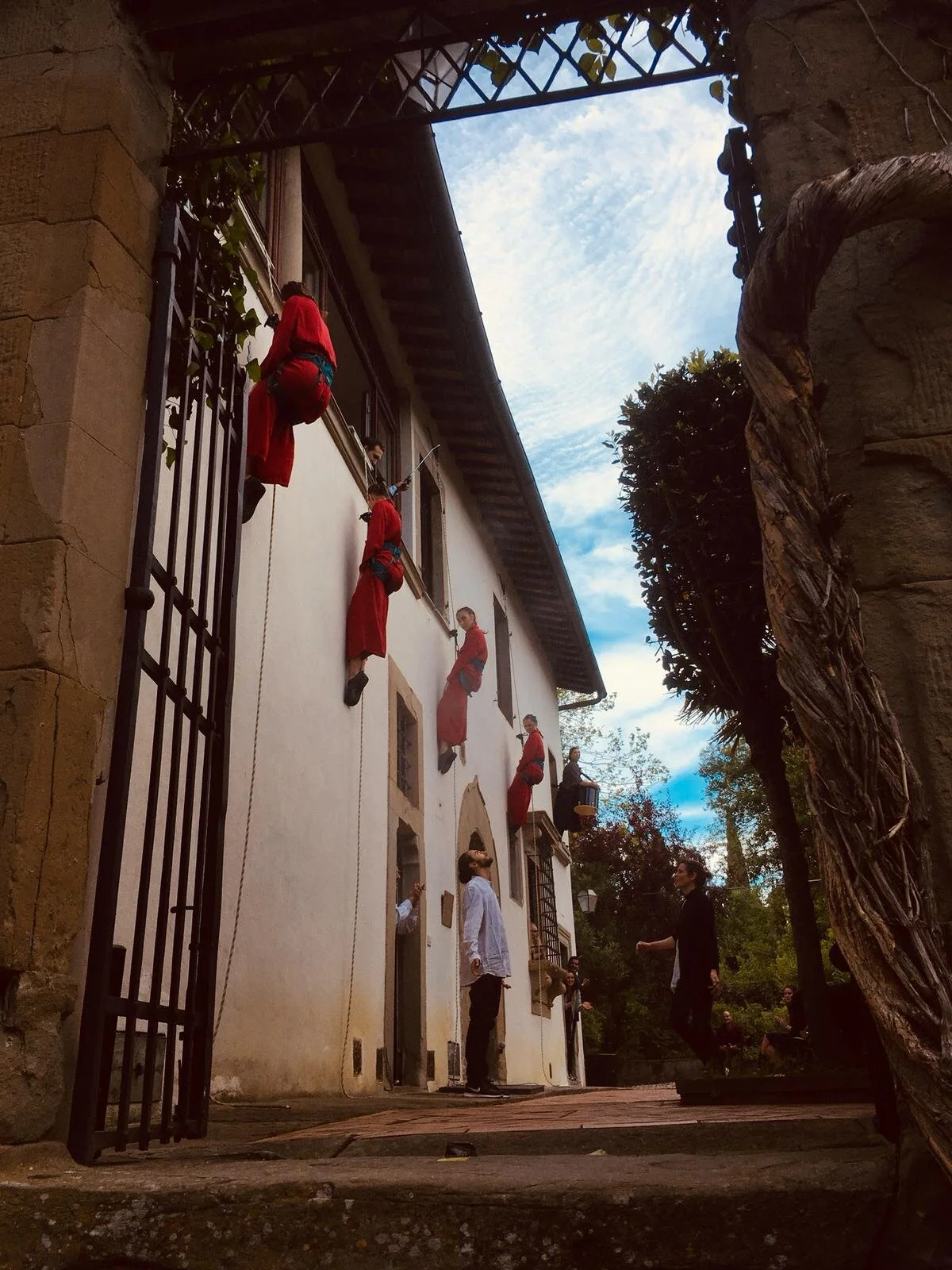Vernon Lee, Walter Pater, and the Revival of Medieval Theatre
Guest post: Elisa Bizzotto, Iuav University of Venice
Fig. 1: Vernon Lee’s The Ballet of the Nations, Villa il Palmerino, Florence, 31 May 2019. Dir. Angeliki Papoulia. Photo: Giuseppe Sabella. Courtesy of Federica Parretti and the Associazione Culturale il Palmerino.
Vernon Lee’s The Ballet of the Nations. A Present-Day Morality (1915) – a strange, heavily allegorical play saturated with ritualism and violence – has often been considered as a unique text, with Gillian Beer and Patricia Pulham stressing the point.[i] While agreeing on its originality, I believe, however, that Lee’s play can be inscribed within a revival of medieval drama which merged with symbolist poetics at the fin de siècle and after. I think, moreover, that an even more specific derivation for The Ballet of the Nations can be identified in a well-known text by the writer and critic Walter Pater – a detail that equally signals Lee’s interest in medieval theatre, as was in fact not unusual at the turn of the century.
In The Death of Character: Perspectives on Theater after Modernism, theatre scholar Elinor Fuchs argues that the Paris of the early 1890s witnessed a fascination with the Middle Ages that affected the stage in ways that were associated with the occultist vogue within symbolism and decadence. In the drama of the period, Fuchs explains, ‘medievalism ranged from revivals of religious forms to atmospheric evocations of a remote time out of time. […] the medieval craze was closely related to the hermetic revival’.[ii] A product of this cultural ambience was certainly Oscar Wilde’s Salomé (1891), written in Paris and originally in French, whose stereotyped characters, pervasive Biblical intertextuality, repetitive dialogues, and extensive use of figurative language are indeed grounded in such a symbolist-decadent medieval vein. The same model may be seen to underlie another of Wilde’s tragedies, the unfinished La Sainte Courtisane (1894), but also Maurice Maeterlinck’s Pélleas et Mélisande (1893), set in a transcendental medieval atmosphere.
Starting from Paris, these theatrical trends spread transculturally and beyond fin-de-siècle decadence, into the new century, with evidence of their dissemination in Vernon Lee. For instance, Martin Puchner has observed that ‘medieval passion plays’ relying ‘on liturgical and other gestures endowed with religious symbolism’ – which of course may well have included Pagan symbolism – were ‘central for the European avant-garde’.[iii] Such highly experimental works as Gabriele D’Annunzio’s famous Le martyre de Saint Sébastien (1911), or Aleister Crowley’s little-known single act Mr Todd: A Morality (1908), in which a personification of Death makes recurring appearances, and esoteric cycle The Rites of Eleusis (1910), also seem to have derived their Pagan-Christian ritualism and metaphorical significance, along with elements of cross-art performativity, from the theatrical resurgence pointed out by Puchner.
Like all these texts, The Ballet of the Nations, a self-professed ‘Present-Day Morality’, shares both ‘the allegorical framework’ and ‘liminal status’ of medieval drama,[iv] and adopts other cardinal performance practices of early modernity, viewing them as apt forms for the contemporary stage. Thus, the danse macabre or the auto sacramental, the latter of which is indirectly recognised in The Ballet of the Nations as an antecedent, were chosen to convey Lee’s anti-war dissent, so radical and disruptive as to be voiced only through the more spontaneous and uncodified dramatic expressions of apparently less sophisticated ages. It is the character of Satan, ‘the World’s immortal Impresario’, as he is called in the play by ‘Ballet-Master Death’, to allude to the text’s complex intergenre and intermedial overlapping:
[…] that is one reason why I prefer the Ballet of the Nations to any of the other mystery-plays […]. The music is not always very pretty, at once too archaic and too ultra-modern for philistine taste, and the steps are a trifle monotonous. But it gives immense scope for moral beauty, and revives religious feeling in all its genuine primeval polytheism. It answers perfectly to what the Spaniards call an Auto Sacramental, a sacred drama having all the attractions of a bull-fight.[v]
According to Gill Plain, this ambiguous crossing of genres, modes and media is imbricated with the text’s representation of extreme acts of bodily violence, mutilation, and quasi annihilation, for such brutality could only be conveyed through a text that dramatises the Kristevian notion of the abject. The Ballet of the Nations, Plain contends,
is ‘composite’: in terms of genre, it encompasses elements of the auto da fé, the auto sacramental, sacred ballets performed at Corpus Christi, the medieval mystery play and Aristotelian tragedy. In raising images of entrails, blood, dismemberment, ‘uncertain forms’ and ‘unspeakable hybrids (Ballet), it also invokes that which, according to Kristeva, problematizes representation – the abject body […].[vi]
Fig. 2: Maxwell Armfield, Illustration to The Ballet of the Nations, first edition (1915). Public domain.
For all its possible derivations from both medieval drama and symbolist-decadent morality plays, my view is that an even more distinct source text for The Ballet of the Nations can be detected in Pater’s imaginary portrait ‘Denys l’Auxerrois’ (1886), which is a most characteristic piece of fin-de-siècle short fiction. Set in the late Middle Ages and retelling the story of Dionysus as an exiled deity in Christian times, ‘Denys l’Auxerrois’ is admittedly the main hypotext in Lee’s ‘Dionysus in the Euganean Hills’ (1921), a partly autobiographical essay hybridised with the fantastic mode and belonging to Lee’s Modernist production, just like The Ballet of the Nations. The three texts – ‘Denys l’Auxerrois’, ‘Dionysus in the Euganean Hills’ and The Ballet – seem to me to engage in a triangulated dialogue based on their common rewriting of pre-modern popular or folk forms of performativity in which Paganism and Christianity commingle and convey typically decadent issues of violence and morbidity, art-induced ecstasy and frenzy, and gender and sexual blurring as related to bodily performativity.
My argument is that Lee may have identified fundamental ideas for her morality play in the passages of ‘Denys l’Auxerrois’ that narrate late-medieval and early-modern performative practices. These passages lay special stress on the appalling violence – ‘gruesome’ is the adjective Lee uses to define ‘Denys l’Auxerrois’ in ‘Dionysus in the Euganean Hills’ – implicated in those very practices and in their immediate reception. I am referring, in particular, to the final part of Pater’s imaginary portrait, in which a ‘rude popular pageant’ is performed with a personification of Winter getting ‘hunted blindfold through the streets’ of the town. Denys, the story’s protagonist, is about to play the Winter part when his lip gets scratched and the sight of blood suddenly pervades the audience ‘with a kind of mad rage’ that unleashes on him the most savage instincts in an unconscious re-enactment of the ritual death of Dionysus in Greek mythology. Here is Pater’s full description:
The festival would end at nightfall with a somewhat rude popular pageant, in which the person of Winter would be hunted blindfold through the streets. […] Hastily […] [Denys] donned the ashen-grey mantle, the rough haircloth about the throat, and went through the preliminary matter. And it happened that a point of the haircloth scratched his lip deeply, with a long trickling of blood upon the chin. It was as if the sight of blood transported the spectators with a kind of mad rage, and suddenly revealed to them the truth. The pretended hunting of the unholy creature became a real one, which brought out, in rapid increase, men’s evil passions. The soul of Denys was already at rest, as his body, now borne along in front of the crowd, was tossed hither and thither, torn at last limb from limb. The men stuck little shreds of his flesh, or, failing that, of his torn raiment, into their caps; the women lending their long hairpins for the purpose. The monk Hermes sought in vain next day for any remains of the body of his friend. Only, at nightfall, the heart of Denys was brought to him by a stranger, still entire.[vii]
Pater lingers on the moment in which the street-stage hunting turns into a real lynching, thus offering a fine example of the power of artistic reception to trigger emotions and actions. This is a central and long-lasting theme of Lee’s aesthetics, originating in the 1890s, developed through the years, and becoming the subject of several essays collected in the volume Beauty and Ugliness and Other Studies in Psychological Aesthetics (1912), co-authored with her then-companion Clementine Anstruther-Thomson. In these aesthetic writings, she recorded physical reactions to the contemplation of artworks and elaborated complex theories around the concept of Einfühlung, i. e. the empathy, or involvement, that stems from artistic reception and can cause body movements and changes, sometimes even extreme ones. Whereas Lee’s studies concentrate on the fruition of visual arts, her ideas can be extended to drama, theatre and dance, where studies of empathy and kinaesthetic empathy are established fields in their own right.[viii] This is exactly what the author might have recognised in Pater’s imaginary portrait and decided to further explore in The Ballet of the Nations, with the aim of transposing and probing her aesthetic theories in a work of verbal creativity.
The last part of ‘Denys l’Auxerrois’ undergoes two dynamics of adaptation in Lee. There is an intergenre adaptation, in which the meta-theatrical portion of Pater’s text is rewritten into an actual play, The Ballet of the Nations. There is also an intragenre adaptation, with Lee’s potential pageant based on Pater becoming hyper-dramatised through an extreme emphasis on its decadent vein. This happens by turning the slaughter of a single scapegoatish character into a collective dismembering in which the personified Nations dance while ‘lopping each others’ limbs and blinding one another with spirts of blood and pellets of human flesh’, thus progressively erasing their human and gendered bodies and becoming amorphous lumps only recognisable by their heads. Here is the whole passage:
Yet dance they did, lopping each others’ limbs and blinding one another with spirts of blood and pellets of human flesh. And as they appeared and disappeared in the moving wreaths of fiery smoke, they lost more and more of their original shape, becoming, in that fitful light, terrible uncertain forms, armless, legless, recognisable for human only by their irreproachable-looking heads which they carried stiff and high even while crawling and staggering along, lying in wait, and leaping and rearing and butting as do fighting animals […].[ix]
Lee’s butchering dance iterates symbolic gestures and actions, as was typical of medieval theatre and appropriated by avant-garde aesthetics, but fundamentally expands on Pater’s narrative sequence of rending and lacerating Denys’s body. What Lee does not seem to derive at all from Pater is, however, the epilogue of her story. Whereas ‘Denys l’Auxerrois’ closes on the protagonist’s Dionysian dismembering, which appears as an apotropaic sacrifice to bring in the Renaissance – a recurring Paterian theme, pivotal to his most famous volume, Studies in the History of the Renaissance (first publ. 1873) – Lee’s mutilated and disfigured nations do not die, and her play ends by not ending, is indeed an open work, with the final announcement that the ‘Ballet of the Nations is still a-dancing’. Apparently, no regeneration comes from Lee’s ritualistic carnage, thus pre-echoing the high-Modernist stances on the impossibility of cultural and epistemic rebirth in T. S. Eliot’s Wasteland (1922), which would be published just a few years hence.
Fig. 3: Lee’s The Ballet of the Nations, Villa il Palmerino, Florence, 31 May 2019. Dir. Angeliki Papoulia. Photo: Giuseppe Sabella. Courtesy of Federica Parretti and the Associazione Culturale il Palmerino.
On the other hand, Lee’s polysemic (non)conclusive statement can be read as proof of the play’s continuous capacity for artistic self-regeneration: The Ballet of the Nations is still calling for audiences and scholars to participate not only in hermeneutic and receptive processes, but also in performative re-creations. This is what happened in the 2019 production of the play at the Villa il Palmerino, Lee’s house on the outskirts of Florence, produced by Federica Parretti and directed by Angeliki Papoulia, with the assistance of Sally Blackburn-Daniels, and the collaboration of both professional and amateur actors and of a ballet company led by Elisa Barucchieri. The momentous performance, which has resisted and disproved previous beliefs that the play’s production were an impossible one,[x] has newly set the play ‘a-dancing’ for more research and representative practices. It has shown that The Ballet of the Nations is not only a work to be read, due to its marked literary quality, and hence a suitable subject for scholarly scrutiny as an autonomous and self-sufficient practice, but one which offers ample possibilities for an exploration of the enactment and embodiment of the poetics of decadence. In this latter sense, especially, it is indeed a unique piece of art, radically probing into the realm of decadent performativity in the long fin de siècle, but also as a trans-historical and trans-cultural phenomenon.
Notes
[i] See Patricia Pulham, ‘Violence and the Pacifist Body in Vernon Lee’s The Ballet of the Nations’, in Petra Rau, ed., Conflict, Nationhood and Corporeality in Modern Literature. Bodies-at-War (Basingstoke: Palgrave Macmillan, 2010), 46-47.
[ii] Elinor Fuchs, The Death of Character: Perspectives on Theater after Modernism (Bloomington: Indiana University Press, 1996), 36.
[iii] Martin Puchner, Stage Fright: Modernism, Anti-Theatricality, and Drama (Baltimore: Johns Hopkins University Press, 2002), 208, n. 15.
[iv] Catherine Maxwell and Patricia Pulham, eds, Vernon Lee: Decadence, Ethics, Aesthetics (Basingstoke and New York: Palgrave, 2006), 15.
[v] Vernon Lee, The Ballet of the Nations. A Present-Day Morality, with a pictorial commentary by Maxwell Armfield (New York: Putnam, 1915).
[vi] Gill Plain, ‘Violence and the Pacifist Body in Lee’s Ballet of the Nations’, in Conflict, Nationhood and Corporeality in Modern Literature: Bodies-at-War (Basingstoke and New York: Palgrave Macmillan, 2010), 58.
[vii] Walter Pater, ‘Denys l’Auxerois’, in Imaginary Portraits, ed. by Lene Østermark-Johansen (Oxford: Oxford University Press, 2019), 94-95.
[viii] See, for instance, Susan Leigh Foster, Choreographing Empathy: Kinesthesia in Performance (Abingdon and New York: Routledge, 2011).
[ix] Lee, The Ballet of the Nations.
[x] See Maxwell and Pulham, 15.



